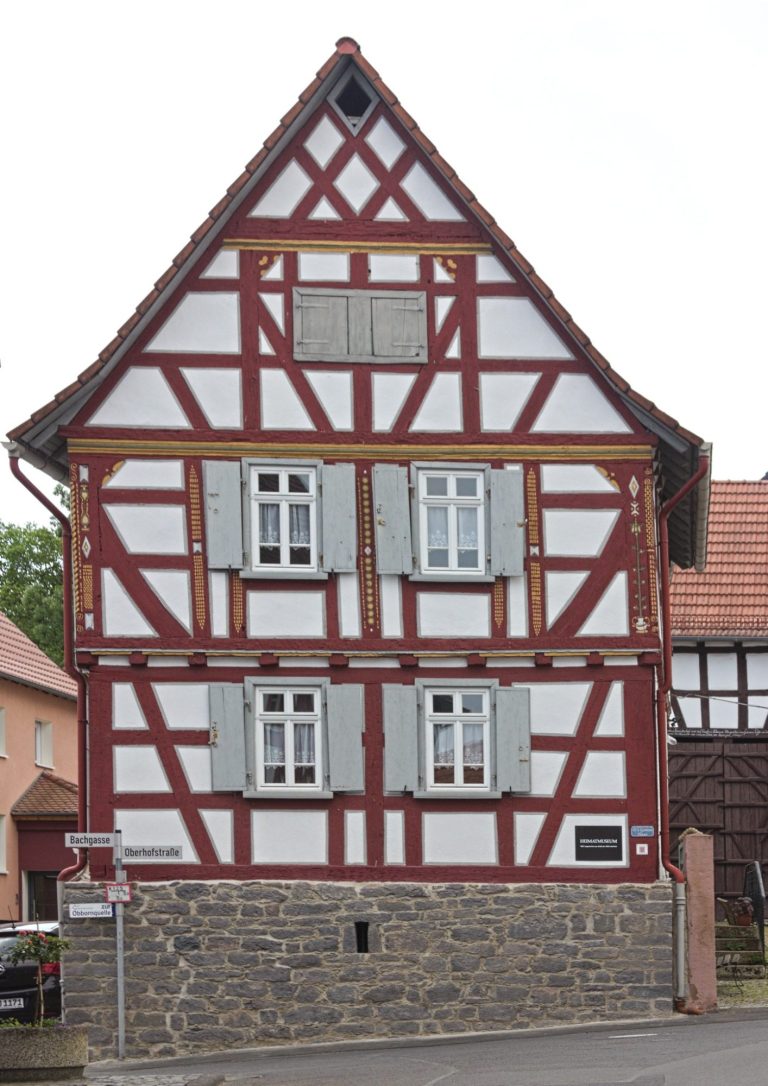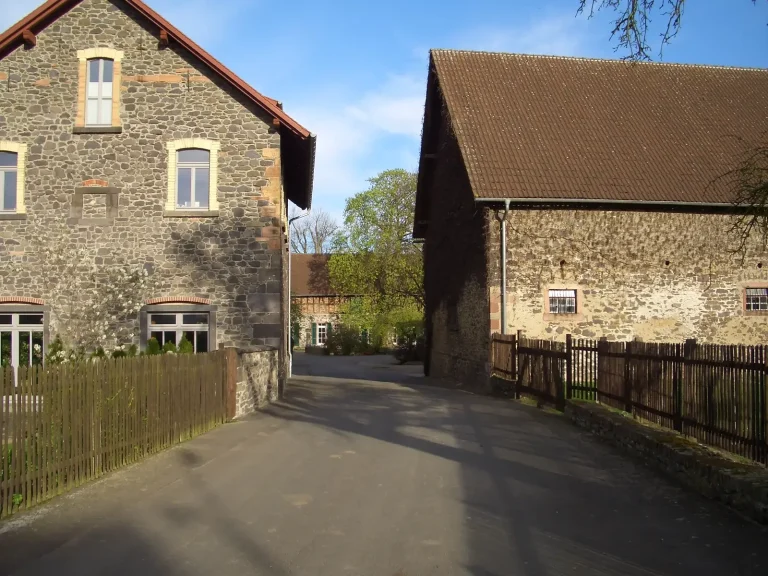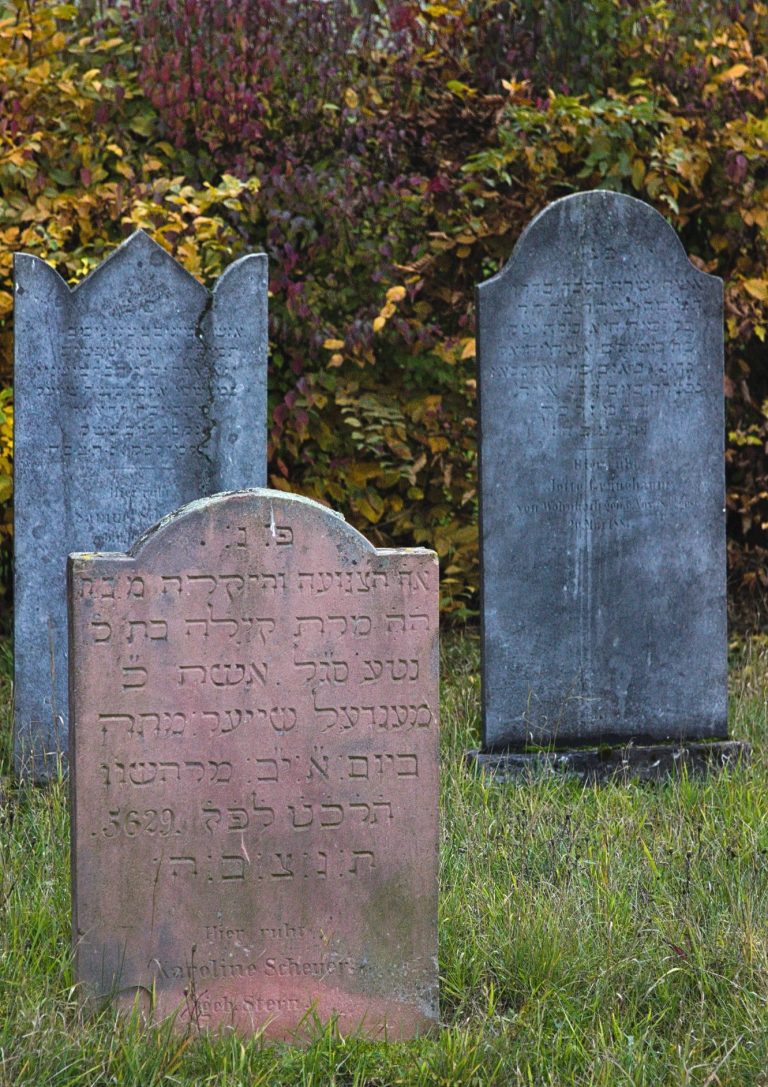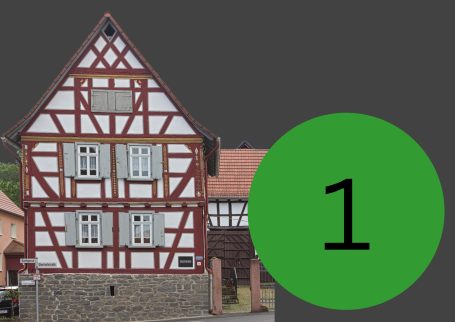Digital Museum
History of Obbornhofen
History Museum
A House of many (hi-)storys
The local museum forms a historical ensemble with the attached barn and the town hall opposite. The building was once the so-called "Gemoa House" ("community hall"). It was owned by the village, temporarily housed a school and provided housing for people who were temporarily without a roof over their heads.
The half-timbered building is richly decorated. There are flat carvings in the beams everywhere. The local history society was founded in 1967. The occasion was Obbornhofen's 1200th anniversary. The museum was set up in 1981 and has been looked after by the local history society ever since.
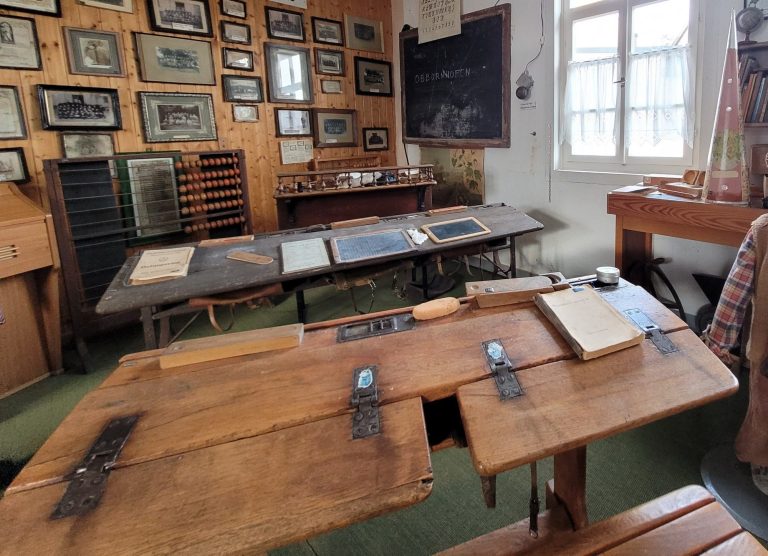
The museum brings together exhibits on the themes of "village tradition" and "everyday life" in the Wetterau. Since 1967, objects, memories and texts on the history of Obbornhofen have been kept here and made accessible. The subject areas are diverse. Everyday life in earlier years is always the focus. Special exhibits include a large intact loom and a miner's uniform from the nearby mining industry. Brown coal was mined in open-cast mines near Obbornhofen until the 1960s. The barn in the background of the local history museum is a "travel barn". It was built here from 2006 and was previously dismantled in Unter-Widdersheim, about ten kilometers away. The half-timbered construction made it possible to dismantle the beam structure and rebuild it here. Today it is used as a venue for cultural events and all kinds of festivals.
Town Hall
An important place
The town hall in Obbornhofen is one of the most important half-timbered buildings in the Wetterau region. It is located at the intersection of Oberhofstrasse, Untergasse and Bachgasse. Its appearance has made it well-known far beyond the village's borders. It is the oldest preserved (half-timbered) town hall in the district of Giessen.
The two-storey building with a high gable roof was built around 1500 in the late Gothic style. The ground floor contains further exhibits (vehicles, old clockworks from the church). The mayor of Obbornhofen resided on the upper floor until the regional reform in Hesse in 1977. Today this room is the wedding room and is used for special exhibitions.
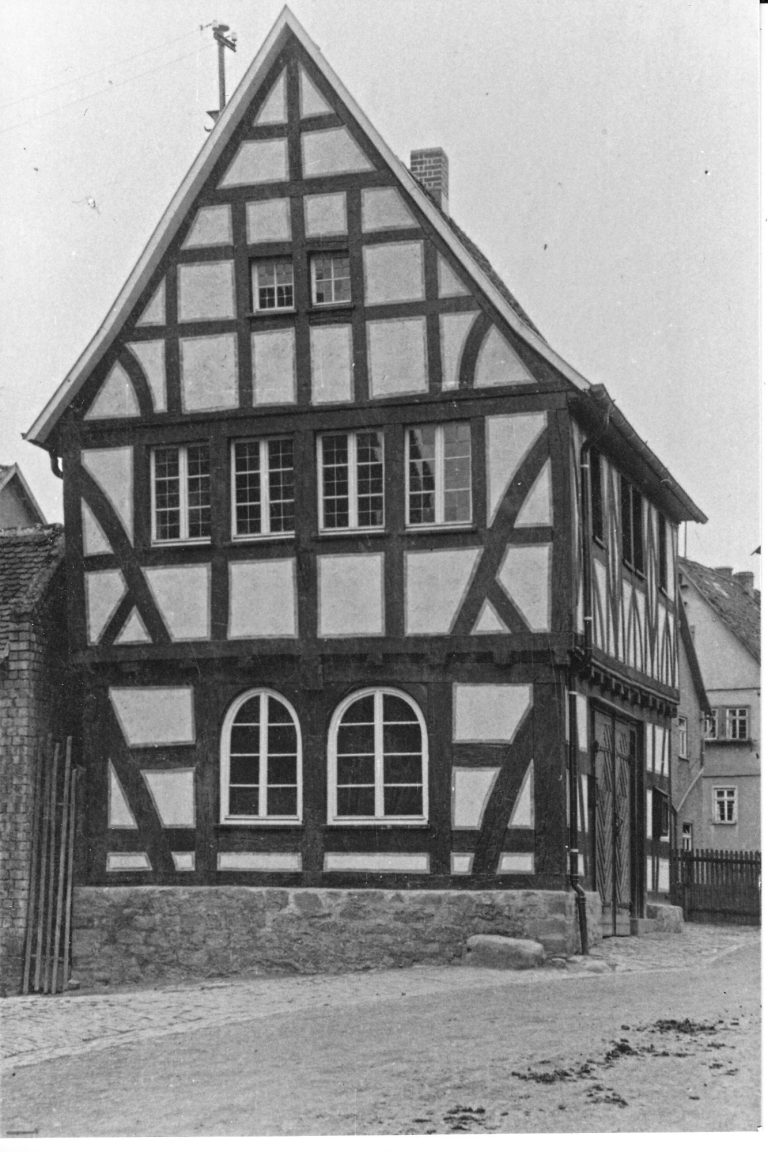
From the first documented mention to the present day, Obbornhofen's affiliation has changed 20 times, from the Wölfersheim office within the county of Solms-Braunfels in the Holy Roman Empire to its incorporation into the Gießen administrative district in 1981. The village was a comparatively small administrative unit.
In 1830, Obbornhofen had 477 inhabitants (today: 872 - as of December 31, 2023). In the centuries before, there were probably not much more.
The place where the town hall still stands today was probably a central meeting place before 1500. Justice was also administered here. The pillory stone has been preserved to this day as a base, which is located directly next to the town hall building. Minor offenses were punished here. Major crimes were subject to the jurisdiction of the feudal and territorial lords. Anyone who committed offenses was publicly pilloried here.
Obborn Fountain
Life happened here
Even before the village was first mentioned in a document, there must have been a plentiful water source in Obbornhofen. Otherwise, people would probably not have settled here and farmed. The first farms were built above the spring - an artesian well - i.e. "above the spring": "Oberenhouen" - this is how the place is called in the first documented mention in 767 in the Lorsch Codex.
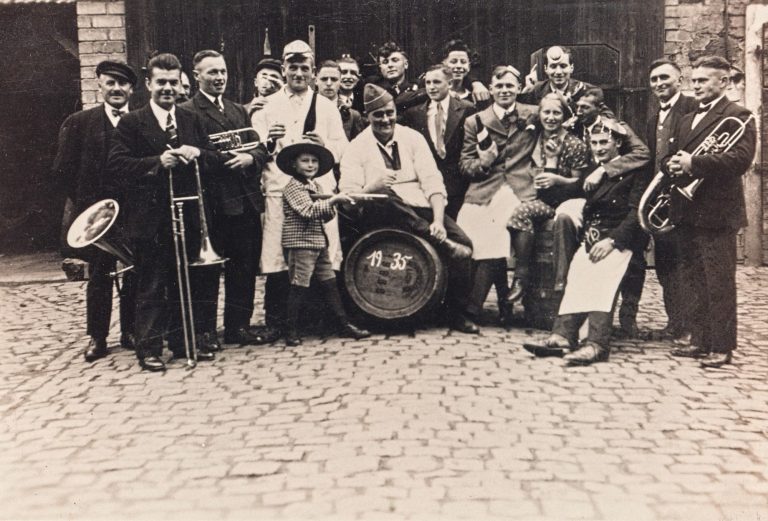
The watercourse was once used to water the cattle. Many of the village's children used to learn to swim here. Laundry was also bleached here. Today the watercourse is contained by shallow pools. The tower, which dates back to 1928, houses a pumping system. To this day, the Obborn is the perfect place to have a little chat and find out what's new.
In Obbornhofen, socializing and club life have always played an important role. There are around 12 clubs to this day. The men's choir "Frohsinn" was the oldest of them (founded in 1903). At one point in Obbornhofen there were five inns with dance halls and a bowling alley.
A special feature that made the place known beyond the village's borders was the cinema. In 1903, Karl Henzel opened the "Zur neuen Welt" inn on what is now Vogelsbergstrasse. Between 1951 and 1963, he ran the "Lichtspielhaus neue Welt" with around 200 seats here with his son and grandson. It mainly showed local films. However, there was also a special program for children.
Hofgut
Ancient Sources
The farm is located on the southeastern edge of the old village buildings. Its history began in 1343, when it was first mentioned in documents as "Mönchhof", later as Komenthurhof. The term "Komtur" refers to the head of a religious order. In Obbornhofen this was the Teutonic Order. It was later taken over by the Counts of Solms zu Lich. The oldest parts of the farm that have been preserved today, the farm buildings inside, date back to the 17th century.
The building material for other buildings came partly from the demolition of buildings belonging to the Arnsburg monastery. The large barn has a ridge height of 18 metres. In the past, a threshing machine could be operated inside. The importance of the farm for the town is also reflected in the street name "Kommenturgasse".

In 1838, the Count of Solms Laubach acquired the land on which the later farm was to be built from Baron Bernhard Schenk zu Schweinsberg. The estate included 403 acres, or just over 100 hectares of land. As the buildings they had taken over were dilapidated, the new owners decided to build a large storage barn and distillery on the "green field" on the outskirts of the village towards Wohnbach. Initially, the farm buildings were built with large gaps between them due to the high risk of fire. It was not until 1851 that the house in the upper village was demolished and rebuilt on the farm.
In 1887, the Solms-Laubach family sold the entire business, including inventory and supplies, to the agricultural vocational school teacher Richard Bornemann, whose descendants now run the farm in the 4th generation. The farm is still used primarily for agricultural purposes. The large barn still serves as a grain store. The farm today (2024) cultivates 600 hectares of arable land in various districts.
In its heyday before the First World War, the farm employed around 50 people from Obbornhofen and the surrounding area. The small farmers were able to supplement their meager wages here.
The agricultural calendar determined life in the village: from sowing the grain in spring to working in the house and yard in the dark winter months. Almost every family had at least one head of livestock and a small field to cultivate. There were also craftsmen such as butchers, bakers, blacksmiths and carpenters. Despite the manageable number of inhabitants, almost all important trades were represented in the village at the beginning of the 19th century.
Obbornhofen also had a midwife, known as the "Kindfraa". A total of four smaller grocery stores existed here in the 1920s and early 1930s. At least one of them still existed until the 1980s.
Synagogue and Jewish Cemetery
An important community
The house at Kommenturgasse 9 was once the building of the synagogue. There was evidence that there had been Jewish residents in Obbornhofen since the early 17th century. The synagogue was built in 1879 as a plastered half-timbered building. It could accommodate up to 60 people. The building was used as a religious school and community center.
During the Kristallnacht pogrom on November 9, 1938, it was plundered and its interior was largely destroyed. During the Second World War, it served as accommodation for forced laborers. The building was later extensively restored and now serves as a residential building.
Around 1900, there were two Jewish families in Obbornhofen: a cattle dealer and a "grocery dealer" (grocer). By this time, the number of Jews in the town had already declined significantly. Like many other non-Jewish families, they emigrated to the USA to escape the comparatively poor supply situation and poverty. Although Obbornhofen had only a few Jewish residents, due to its location it served for a time as a center for other Jewish residents of the surrounding towns. There were close connections to Bellersheim and Wohnbach, where the number of Jewish residents was significantly higher.
The Jewish cemetery outside the town served as the final resting place for the Jewish residents of all three towns. The synagogue was visited by everyone. After the Nazis seized power on January 30, 1933, the situation changed dramatically. Repression began immediately. The Jewish grocery store was boycotted. By 1938, the Jewish residents had left the village under the pressure of the National Socialist racial laws.
The Jewish cemetery, like the synagogue, was destroyed on November 9, 1938 during the Kristallnacht pogrom. Gravestones were overturned and broken. After the end of the war, the cemetery was restored. The synagogue building became a residential building. A memorial plaque in the Jewish cemetery in Hungen commemorates the fate of the Jews from Obbornhofen.
Church
Spiritual Life
The church is the most striking building in the old town centre. A parish in Obbornhofen was first mentioned in 1333. It is likely that there were wooden chapels and churches around 500 years earlier.
The origins of the present church lie in the 12th or 13th century. The choir, where the altar stands, is the oldest part of the building. In 1742, the nave was rebuilt in the Baroque style. The church had great significance in the life cycle of the Obbornhofen residents: from baptism to death.

Everyday life in the village was strongly influenced by agriculture and its hard work. The church offered a break. Sunday was a day off from work and was reserved for going to church. This was not just about faith and the Christian way of life. In the conversations before and after the service, important news was exchanged and business deals were initiated. Each family sent a "delegation" to go to church on Sundays if not every person in a household could go.
People and their relatives were accompanied by the church during the major transitions and changes in life. This began after birth with baptism, which in earlier times took place at home and not in church. The confirmation period usually lasted two years. After confirmation, working life began for most young people. For another 1 to 2 years after confirmation, young adults continued to be taught their faith through Christian teaching.
Weddings were celebrations that included the wedding ceremony in church. It was not uncommon for the whole village to take part in such celebrations. Death and saying goodbye were also part of it and were accompanied by the village community at home, in the church and at the cemetery. A special feature in Obbornhofen was the so-called death crown. When a child or young person died, it was placed on the coffin of the deceased and the coffin was then carried in a solemn procession through the village to the cemetery. This custom was maintained in Obbornhofen for around 300 years until the beginning of the 20th century.
© Urheberrecht. Alle Rechte vorbehalten.
Wir benötigen Ihre Zustimmung zum Laden der Übersetzungen
Wir nutzen einen Drittanbieter-Service, um den Inhalt der Website zu übersetzen, der möglicherweise Daten über Ihre Aktivitäten sammelt. Bitte überprüfen Sie die Details in der Datenschutzerklärung und akzeptieren Sie den Dienst, um die Übersetzungen zu sehen.
